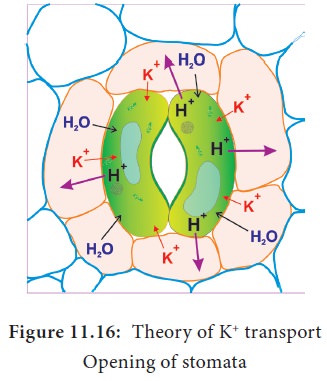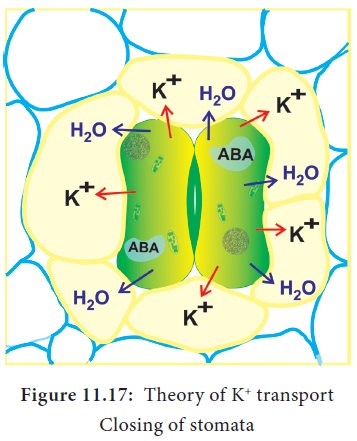Chapter: 11th Botany : Chapter 11 : Transport in Plants
Mechanism of Stomatal Movementбґ
Mechanism of Stomatal
Movementбґ
Stomatal
movements are regulated by the change of turgor pressure in guard cells. When
water enters the guard cell, it swells and its unevenly thickened walls stretch
up resulting in the opening of stomata. This is due to concave non-elastic
nature of inner wall pulled away from each other and stretching of the convex
elastic natured outer wall of guard cell.
Different theories have been proposed regarding opening and closing of stomata. The important theories of stomatal movement are as follows,
1. Theory of Photosynthesis in guard cells
2. Starch Б─⌠ Sugar interconversion theory
3. Active potassium transport ion concept
1.
Theory of Photosynthesis in guard cells
Von Mohl (1856) observed that stomata open in light and close in the night.
According to him, chloroplasts present in the guard cells photosynthesize in
the presence of light resulting in the production of carbohydrate (Sugar) which
increases osmotic pressure in guard cells. It leads to the entry of water from
other cell and stomatal aperture opens. The above process vice versa in night leads to closure of stomata.
Demerits
1.
Chloroplast of guard cells is poorly developed and
incapable of performing photosynthesis.
2. The guard cells already possess much amount of stored sugars.
2.
Starch Б─⌠
Sugar Interconversion theory
i.Б─┌
According to Lloyd (1908), turgidity of guard cell depends on
interconversion, of starch and sugar. It was supported by Loftfield (1921) as he found guard cells containing sugar during the daytime when they are open and starch
during the night when they are closed.
ii.
Sayre (1920) observed that the opening and closing of stomata
depends upon change in pH of guard cells. According to him stomata open at high
pH during day time and become closed at low pH at night. Utilization of CO2
by photosynthesis during light period causes an increase in pH resulting
in the conversion of starch to sugar. Sugar increase in cell favours endosmosis
and increases the turgor pressure which leads to opening of stomata. Likewise,
accumulation of CO2 in cells during night decrease the pH level
resulting in the conversion of sugar to starch. Starch decreases the turgor
pressure of guard cell and stomata close.
iii.Б─┌ The
discovery of enzyme phosphorylase in
guard cells by Hanes (1940) greatly
supports the starch-sugar interconversion theory. The enzyme phosphorylase hydrolyses starch into
sugar and high pH followed by
endosmosis and the opening of stomata during light. The vice versa takes place during the night.

iv.Б─┌ Steward (1964) proposed a slightly modified
scheme of starch-sugar interconversion theory. According to him,
Glucose-1-phosphate is osmotically inactive. Removal of phosphate from Glucose-
1-phosphate converts to Glucose which is osmotically active and increases the
concentration of guard cell leading to opening of stomata (Figure 11.15).
Objections to Starch-sugar interconversion theory
i.Б─┌ In
monocots, guard cell does not have starch.
ii.Б─┌ There is no evidence to show the presence of sugar at a time when starch disappears and stomata open.
iii.Б─┌ It
fails to explain the drastic change in pH from 5 to 7 by change of CO2.

3. Theory of K+ transport
This
theory was proposed by Levit (1974)
and elaborated by Raschke (1975).
According to this theory, the following steps are involved in the stomatal
opening:

In light
i. In
guard cell, starch is converted into organic acid (malic acid).
ii.
Malic acid in guard cell dissociates to malate
anion and proton (H+).
iii.
Protons are transported through the membrane into
nearby subsidiary cells with the exchange of K+ (Potassium ions) from
subsidiary cells to guard cells. This process involves an electrical gradient
and is called ion exchange.
iv.
This ion exchange is an active process and consumes
ATP for energy.
v.
Increased K+ ions in the guard cell are balanced by
ClБ─⌠ ions. Increase in solute concentration decreases the water potential in the
guard cell.
vi.
Guard cell becomes hypertonic and favours the entry
of water from surrounding cells.
vii. Increased
turgor pressure due to the entry of water opens the stomatal pore (Figure
11.16).
In Dark

i. In
dark photosynthesis stops and respiration continues with accumulation of CO2
in the sub-stomatal cavity.
ii.
Accumulation of CO2 in cell lowers the pH level.
i.
Low pH and a shortage of water in the guard cell
activate the stress hormone Abscisic
acid (ABA).
iv. ABA
stops further entry of K+ ions and also induce K+ ions to leak out to
subsidiary cells from guard cell.
v. Loss
of water from guard cell reduces turgor pressure and causes closure of stomata
(Figure 11.17).
Related Topics